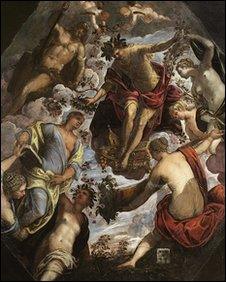Venetian painting by Jacopo Tintoretto to go on show
- Published

The painting will go on display from Wednesday
A restored painting by Renaissance artist Jacopo Tintoretto is to go on public display for the first time.
The work will be displayed at Kingston Lacy in Dorset following a £36,000 conservation project by the National Trust.
The painting has spent most of the last 30 years in storage because of its poor condition.
Tintoretto is considered to be one of the great masters of mid to late 16th Century Venice.
Poor condition
"This is undoubtedly a work of great significance," said Alastair Laing, the National Trust's curator of pictures and sculpture.
"To have a painting by Tintoretto in an English house, rather than still in its original location in Venice, or in an Italian museum, is extraordinary."
The painting was in such poor condition when it was donated to the National Trust in 1981 that only half of it was visible.
Experts were uncertain if it was by Tintoretto but work to clean the 2.67m by 2.34m artwork, as well as X-rays and infrared analysis, helped to identify the artist's style and brush strokes.
Since the mid-19th Century, the painting has been known as Apollo and the Muses.
But in Greek mythology there were nine muses, and there are just seven figures in the picture besides Apollo - who may in fact be the goddess of marriage, Hymen - and two cupids, the National Trust said.
As a result of the restoration, the painting has been re-titled Apollo (or Hymen) Crowning A Poet And Giving Him A Spouse.
But many aspects of the painting remain a mystery, including the presence of Hercules and the significance of objects including a gold cup, a gold box and a gold steeple.
Christine Sitwell, the National Trust's paintings conservation adviser, said: "The cleaning process has revealed the sheer quality and energy of Tintoretto and how he worked, but we're still baffled as to some of the content of the painting.
"We would love anyone out there to tell us what they think it could be."